Effective Nursing Case Management in Patient-Centered Care
VerifiedAdded on 2023/04/21
|8
|1923
|105
Essay
AI Summary
This essay provides a comprehensive overview of nursing case management (CM) as a crucial technique for coordinating patient care, minimizing healthcare costs, and ensuring quality. It highlights the characteristics of CM activities, including community-based programs and the importance of skilled nurses, collaboration, and responsiveness. The essay also discusses the education requirements for CM nurses and examines a conceptual framework involving an undergraduate nursing program's efforts to improve NCLEX success rates through evidence-based strategies, such as course implementation, progression policy adaptation, and exit examination preparation. Furthermore, the analysis of the systematic course and the continuous assessment of student performance are discussed, emphasizing the importance of data collection and analysis to enhance the program's effectiveness and ensure quality healthcare provision.
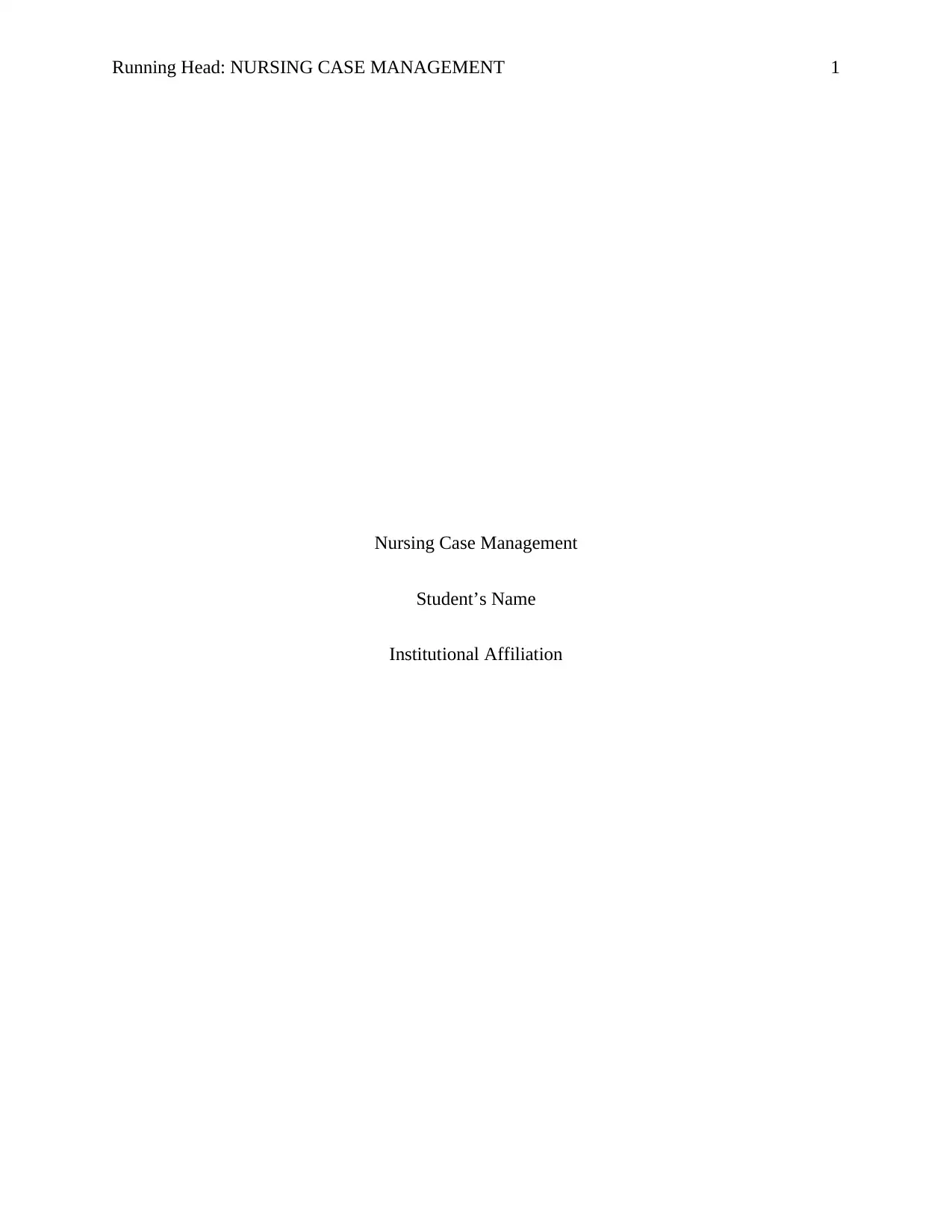
Running Head: NURSING CASE MANAGEMENT 1
Nursing Case Management
Student’s Name
Institutional Affiliation
Nursing Case Management
Student’s Name
Institutional Affiliation
Paraphrase This Document
Need a fresh take? Get an instant paraphrase of this document with our AI Paraphraser
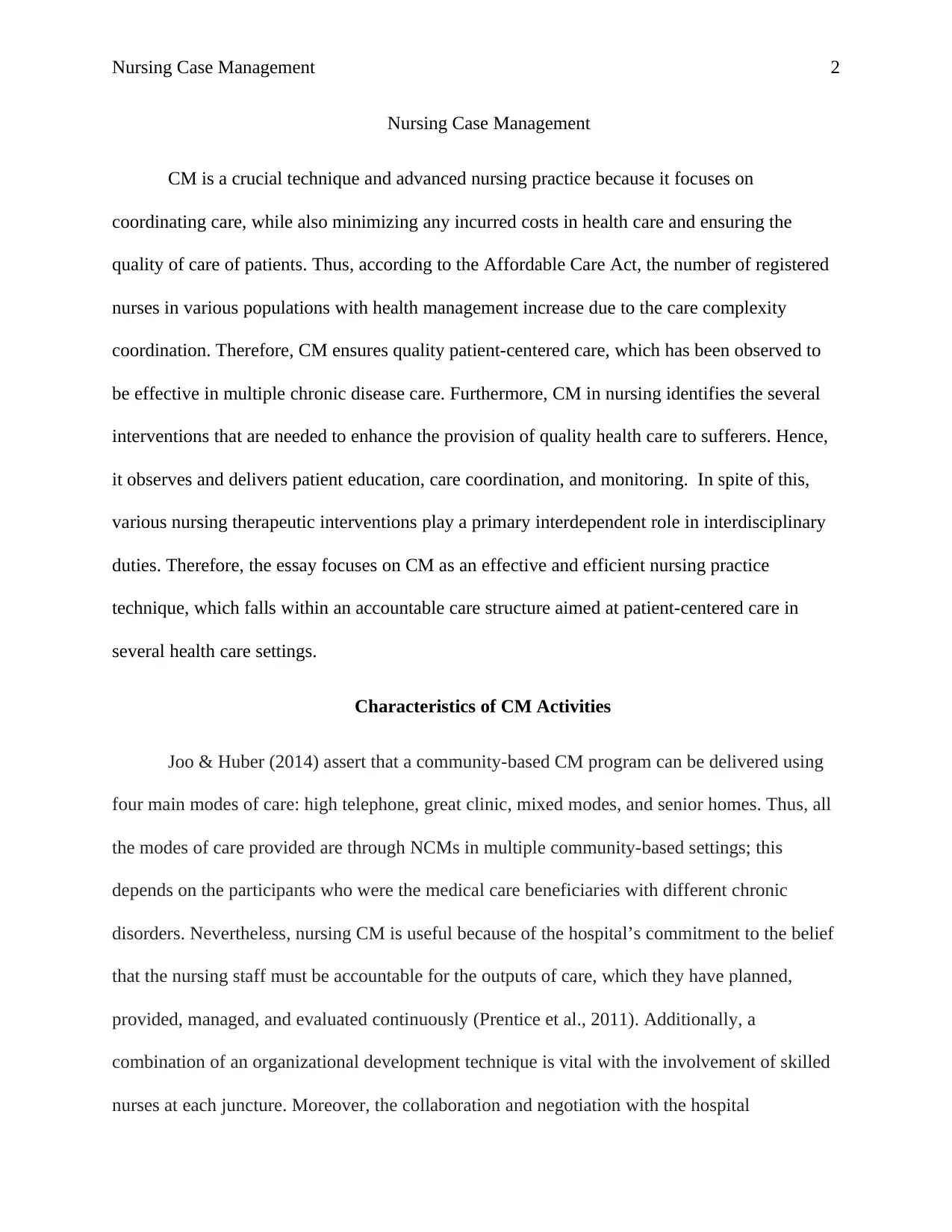
Nursing Case Management 2
Nursing Case Management
CM is a crucial technique and advanced nursing practice because it focuses on
coordinating care, while also minimizing any incurred costs in health care and ensuring the
quality of care of patients. Thus, according to the Affordable Care Act, the number of registered
nurses in various populations with health management increase due to the care complexity
coordination. Therefore, CM ensures quality patient-centered care, which has been observed to
be effective in multiple chronic disease care. Furthermore, CM in nursing identifies the several
interventions that are needed to enhance the provision of quality health care to sufferers. Hence,
it observes and delivers patient education, care coordination, and monitoring. In spite of this,
various nursing therapeutic interventions play a primary interdependent role in interdisciplinary
duties. Therefore, the essay focuses on CM as an effective and efficient nursing practice
technique, which falls within an accountable care structure aimed at patient-centered care in
several health care settings.
Characteristics of CM Activities
Joo & Huber (2014) assert that a community-based CM program can be delivered using
four main modes of care: high telephone, great clinic, mixed modes, and senior homes. Thus, all
the modes of care provided are through NCMs in multiple community-based settings; this
depends on the participants who were the medical care beneficiaries with different chronic
disorders. Nevertheless, nursing CM is useful because of the hospital’s commitment to the belief
that the nursing staff must be accountable for the outputs of care, which they have planned,
provided, managed, and evaluated continuously (Prentice et al., 2011). Additionally, a
combination of an organizational development technique is vital with the involvement of skilled
nurses at each juncture. Moreover, the collaboration and negotiation with the hospital
Nursing Case Management
CM is a crucial technique and advanced nursing practice because it focuses on
coordinating care, while also minimizing any incurred costs in health care and ensuring the
quality of care of patients. Thus, according to the Affordable Care Act, the number of registered
nurses in various populations with health management increase due to the care complexity
coordination. Therefore, CM ensures quality patient-centered care, which has been observed to
be effective in multiple chronic disease care. Furthermore, CM in nursing identifies the several
interventions that are needed to enhance the provision of quality health care to sufferers. Hence,
it observes and delivers patient education, care coordination, and monitoring. In spite of this,
various nursing therapeutic interventions play a primary interdependent role in interdisciplinary
duties. Therefore, the essay focuses on CM as an effective and efficient nursing practice
technique, which falls within an accountable care structure aimed at patient-centered care in
several health care settings.
Characteristics of CM Activities
Joo & Huber (2014) assert that a community-based CM program can be delivered using
four main modes of care: high telephone, great clinic, mixed modes, and senior homes. Thus, all
the modes of care provided are through NCMs in multiple community-based settings; this
depends on the participants who were the medical care beneficiaries with different chronic
disorders. Nevertheless, nursing CM is useful because of the hospital’s commitment to the belief
that the nursing staff must be accountable for the outputs of care, which they have planned,
provided, managed, and evaluated continuously (Prentice et al., 2011). Additionally, a
combination of an organizational development technique is vital with the involvement of skilled
nurses at each juncture. Moreover, the collaboration and negotiation with the hospital
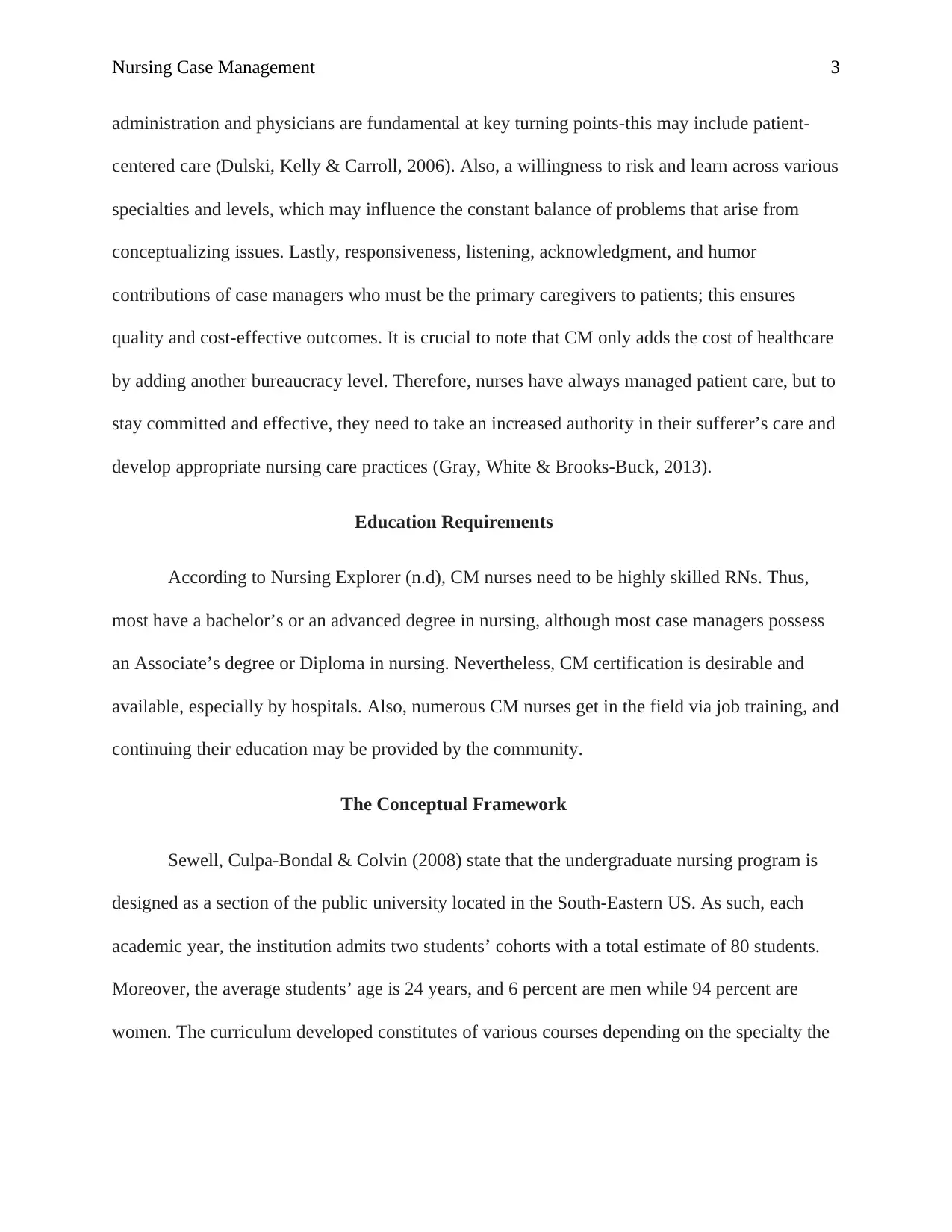
Nursing Case Management 3
administration and physicians are fundamental at key turning points-this may include patient-
centered care (Dulski, Kelly & Carroll, 2006). Also, a willingness to risk and learn across various
specialties and levels, which may influence the constant balance of problems that arise from
conceptualizing issues. Lastly, responsiveness, listening, acknowledgment, and humor
contributions of case managers who must be the primary caregivers to patients; this ensures
quality and cost-effective outcomes. It is crucial to note that CM only adds the cost of healthcare
by adding another bureaucracy level. Therefore, nurses have always managed patient care, but to
stay committed and effective, they need to take an increased authority in their sufferer’s care and
develop appropriate nursing care practices (Gray, White & Brooks-Buck, 2013).
Education Requirements
According to Nursing Explorer (n.d), CM nurses need to be highly skilled RNs. Thus,
most have a bachelor’s or an advanced degree in nursing, although most case managers possess
an Associate’s degree or Diploma in nursing. Nevertheless, CM certification is desirable and
available, especially by hospitals. Also, numerous CM nurses get in the field via job training, and
continuing their education may be provided by the community.
The Conceptual Framework
Sewell, Culpa-Bondal & Colvin (2008) state that the undergraduate nursing program is
designed as a section of the public university located in the South-Eastern US. As such, each
academic year, the institution admits two students’ cohorts with a total estimate of 80 students.
Moreover, the average students’ age is 24 years, and 6 percent are men while 94 percent are
women. The curriculum developed constitutes of various courses depending on the specialty the
administration and physicians are fundamental at key turning points-this may include patient-
centered care (Dulski, Kelly & Carroll, 2006). Also, a willingness to risk and learn across various
specialties and levels, which may influence the constant balance of problems that arise from
conceptualizing issues. Lastly, responsiveness, listening, acknowledgment, and humor
contributions of case managers who must be the primary caregivers to patients; this ensures
quality and cost-effective outcomes. It is crucial to note that CM only adds the cost of healthcare
by adding another bureaucracy level. Therefore, nurses have always managed patient care, but to
stay committed and effective, they need to take an increased authority in their sufferer’s care and
develop appropriate nursing care practices (Gray, White & Brooks-Buck, 2013).
Education Requirements
According to Nursing Explorer (n.d), CM nurses need to be highly skilled RNs. Thus,
most have a bachelor’s or an advanced degree in nursing, although most case managers possess
an Associate’s degree or Diploma in nursing. Nevertheless, CM certification is desirable and
available, especially by hospitals. Also, numerous CM nurses get in the field via job training, and
continuing their education may be provided by the community.
The Conceptual Framework
Sewell, Culpa-Bondal & Colvin (2008) state that the undergraduate nursing program is
designed as a section of the public university located in the South-Eastern US. As such, each
academic year, the institution admits two students’ cohorts with a total estimate of 80 students.
Moreover, the average students’ age is 24 years, and 6 percent are men while 94 percent are
women. The curriculum developed constitutes of various courses depending on the specialty the
⊘ This is a preview!⊘
Do you want full access?
Subscribe today to unlock all pages.

Trusted by 1+ million students worldwide
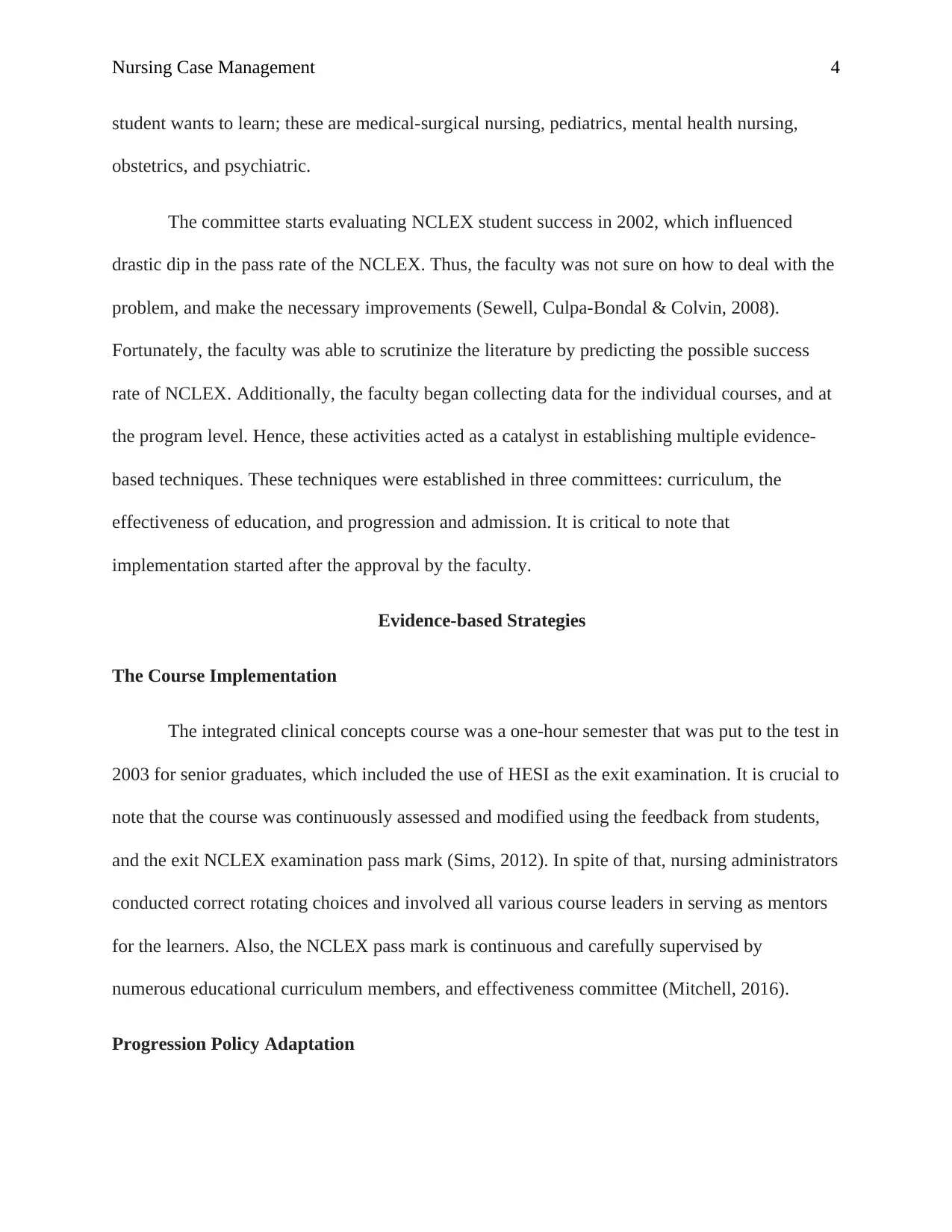
Nursing Case Management 4
student wants to learn; these are medical-surgical nursing, pediatrics, mental health nursing,
obstetrics, and psychiatric.
The committee starts evaluating NCLEX student success in 2002, which influenced
drastic dip in the pass rate of the NCLEX. Thus, the faculty was not sure on how to deal with the
problem, and make the necessary improvements (Sewell, Culpa-Bondal & Colvin, 2008).
Fortunately, the faculty was able to scrutinize the literature by predicting the possible success
rate of NCLEX. Additionally, the faculty began collecting data for the individual courses, and at
the program level. Hence, these activities acted as a catalyst in establishing multiple evidence-
based techniques. These techniques were established in three committees: curriculum, the
effectiveness of education, and progression and admission. It is critical to note that
implementation started after the approval by the faculty.
Evidence-based Strategies
The Course Implementation
The integrated clinical concepts course was a one-hour semester that was put to the test in
2003 for senior graduates, which included the use of HESI as the exit examination. It is crucial to
note that the course was continuously assessed and modified using the feedback from students,
and the exit NCLEX examination pass mark (Sims, 2012). In spite of that, nursing administrators
conducted correct rotating choices and involved all various course leaders in serving as mentors
for the learners. Also, the NCLEX pass mark is continuous and carefully supervised by
numerous educational curriculum members, and effectiveness committee (Mitchell, 2016).
Progression Policy Adaptation
student wants to learn; these are medical-surgical nursing, pediatrics, mental health nursing,
obstetrics, and psychiatric.
The committee starts evaluating NCLEX student success in 2002, which influenced
drastic dip in the pass rate of the NCLEX. Thus, the faculty was not sure on how to deal with the
problem, and make the necessary improvements (Sewell, Culpa-Bondal & Colvin, 2008).
Fortunately, the faculty was able to scrutinize the literature by predicting the possible success
rate of NCLEX. Additionally, the faculty began collecting data for the individual courses, and at
the program level. Hence, these activities acted as a catalyst in establishing multiple evidence-
based techniques. These techniques were established in three committees: curriculum, the
effectiveness of education, and progression and admission. It is critical to note that
implementation started after the approval by the faculty.
Evidence-based Strategies
The Course Implementation
The integrated clinical concepts course was a one-hour semester that was put to the test in
2003 for senior graduates, which included the use of HESI as the exit examination. It is crucial to
note that the course was continuously assessed and modified using the feedback from students,
and the exit NCLEX examination pass mark (Sims, 2012). In spite of that, nursing administrators
conducted correct rotating choices and involved all various course leaders in serving as mentors
for the learners. Also, the NCLEX pass mark is continuous and carefully supervised by
numerous educational curriculum members, and effectiveness committee (Mitchell, 2016).
Progression Policy Adaptation
Paraphrase This Document
Need a fresh take? Get an instant paraphrase of this document with our AI Paraphraser
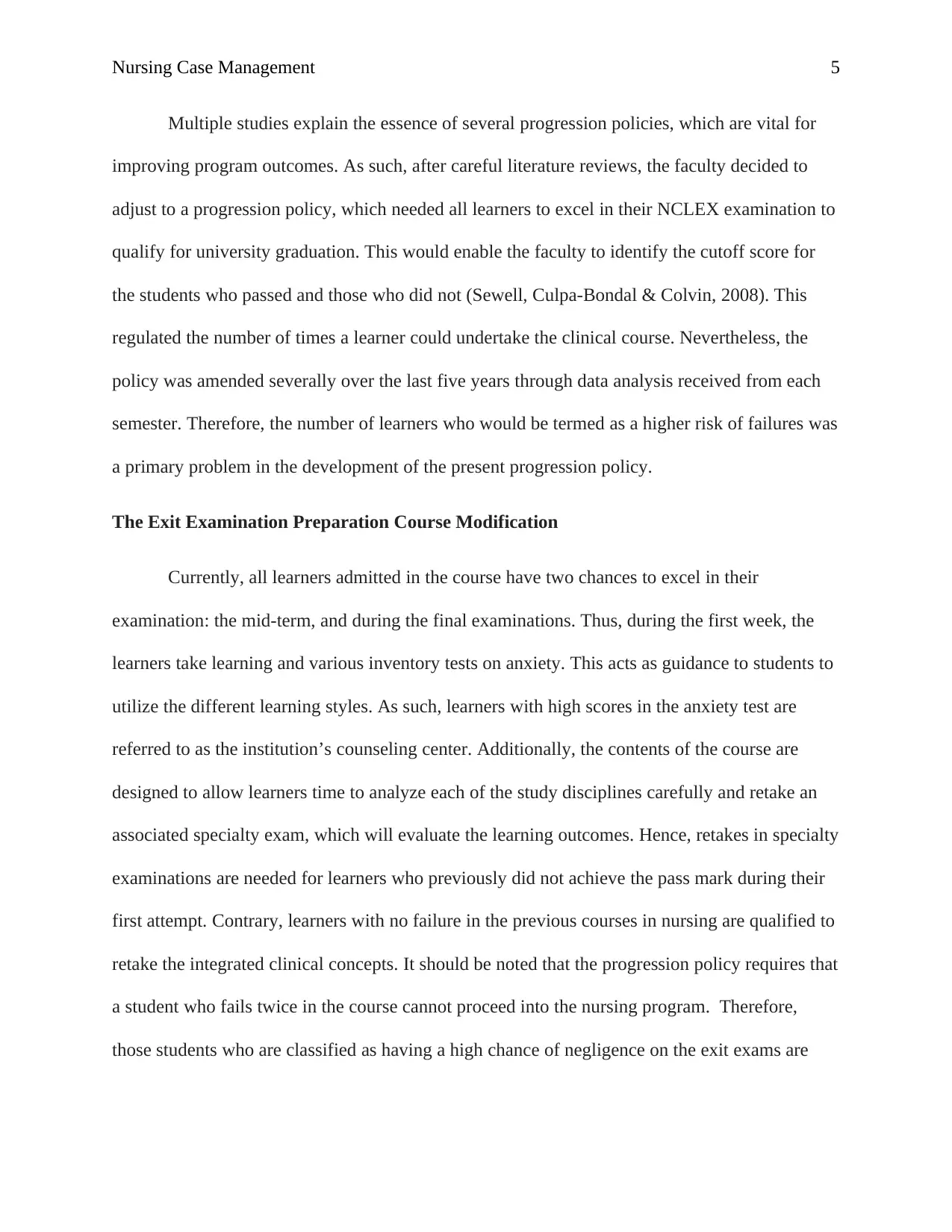
Nursing Case Management 5
Multiple studies explain the essence of several progression policies, which are vital for
improving program outcomes. As such, after careful literature reviews, the faculty decided to
adjust to a progression policy, which needed all learners to excel in their NCLEX examination to
qualify for university graduation. This would enable the faculty to identify the cutoff score for
the students who passed and those who did not (Sewell, Culpa-Bondal & Colvin, 2008). This
regulated the number of times a learner could undertake the clinical course. Nevertheless, the
policy was amended severally over the last five years through data analysis received from each
semester. Therefore, the number of learners who would be termed as a higher risk of failures was
a primary problem in the development of the present progression policy.
The Exit Examination Preparation Course Modification
Currently, all learners admitted in the course have two chances to excel in their
examination: the mid-term, and during the final examinations. Thus, during the first week, the
learners take learning and various inventory tests on anxiety. This acts as guidance to students to
utilize the different learning styles. As such, learners with high scores in the anxiety test are
referred to as the institution’s counseling center. Additionally, the contents of the course are
designed to allow learners time to analyze each of the study disciplines carefully and retake an
associated specialty exam, which will evaluate the learning outcomes. Hence, retakes in specialty
examinations are needed for learners who previously did not achieve the pass mark during their
first attempt. Contrary, learners with no failure in the previous courses in nursing are qualified to
retake the integrated clinical concepts. It should be noted that the progression policy requires that
a student who fails twice in the course cannot proceed into the nursing program. Therefore,
those students who are classified as having a high chance of negligence on the exit exams are
Multiple studies explain the essence of several progression policies, which are vital for
improving program outcomes. As such, after careful literature reviews, the faculty decided to
adjust to a progression policy, which needed all learners to excel in their NCLEX examination to
qualify for university graduation. This would enable the faculty to identify the cutoff score for
the students who passed and those who did not (Sewell, Culpa-Bondal & Colvin, 2008). This
regulated the number of times a learner could undertake the clinical course. Nevertheless, the
policy was amended severally over the last five years through data analysis received from each
semester. Therefore, the number of learners who would be termed as a higher risk of failures was
a primary problem in the development of the present progression policy.
The Exit Examination Preparation Course Modification
Currently, all learners admitted in the course have two chances to excel in their
examination: the mid-term, and during the final examinations. Thus, during the first week, the
learners take learning and various inventory tests on anxiety. This acts as guidance to students to
utilize the different learning styles. As such, learners with high scores in the anxiety test are
referred to as the institution’s counseling center. Additionally, the contents of the course are
designed to allow learners time to analyze each of the study disciplines carefully and retake an
associated specialty exam, which will evaluate the learning outcomes. Hence, retakes in specialty
examinations are needed for learners who previously did not achieve the pass mark during their
first attempt. Contrary, learners with no failure in the previous courses in nursing are qualified to
retake the integrated clinical concepts. It should be noted that the progression policy requires that
a student who fails twice in the course cannot proceed into the nursing program. Therefore,
those students who are classified as having a high chance of negligence on the exit exams are
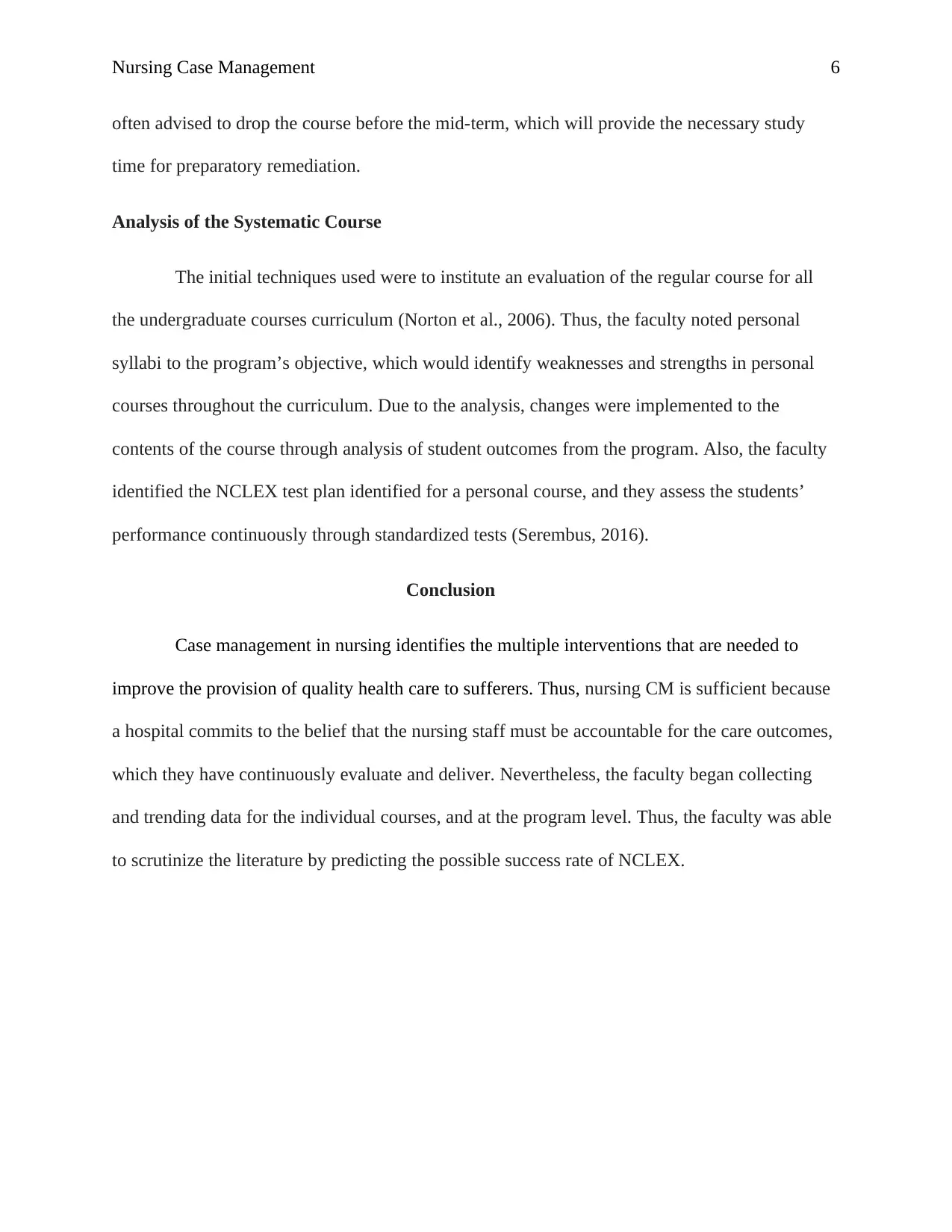
Nursing Case Management 6
often advised to drop the course before the mid-term, which will provide the necessary study
time for preparatory remediation.
Analysis of the Systematic Course
The initial techniques used were to institute an evaluation of the regular course for all
the undergraduate courses curriculum (Norton et al., 2006). Thus, the faculty noted personal
syllabi to the program’s objective, which would identify weaknesses and strengths in personal
courses throughout the curriculum. Due to the analysis, changes were implemented to the
contents of the course through analysis of student outcomes from the program. Also, the faculty
identified the NCLEX test plan identified for a personal course, and they assess the students’
performance continuously through standardized tests (Serembus, 2016).
Conclusion
Case management in nursing identifies the multiple interventions that are needed to
improve the provision of quality health care to sufferers. Thus, nursing CM is sufficient because
a hospital commits to the belief that the nursing staff must be accountable for the care outcomes,
which they have continuously evaluate and deliver. Nevertheless, the faculty began collecting
and trending data for the individual courses, and at the program level. Thus, the faculty was able
to scrutinize the literature by predicting the possible success rate of NCLEX.
often advised to drop the course before the mid-term, which will provide the necessary study
time for preparatory remediation.
Analysis of the Systematic Course
The initial techniques used were to institute an evaluation of the regular course for all
the undergraduate courses curriculum (Norton et al., 2006). Thus, the faculty noted personal
syllabi to the program’s objective, which would identify weaknesses and strengths in personal
courses throughout the curriculum. Due to the analysis, changes were implemented to the
contents of the course through analysis of student outcomes from the program. Also, the faculty
identified the NCLEX test plan identified for a personal course, and they assess the students’
performance continuously through standardized tests (Serembus, 2016).
Conclusion
Case management in nursing identifies the multiple interventions that are needed to
improve the provision of quality health care to sufferers. Thus, nursing CM is sufficient because
a hospital commits to the belief that the nursing staff must be accountable for the care outcomes,
which they have continuously evaluate and deliver. Nevertheless, the faculty began collecting
and trending data for the individual courses, and at the program level. Thus, the faculty was able
to scrutinize the literature by predicting the possible success rate of NCLEX.
⊘ This is a preview!⊘
Do you want full access?
Subscribe today to unlock all pages.

Trusted by 1+ million students worldwide
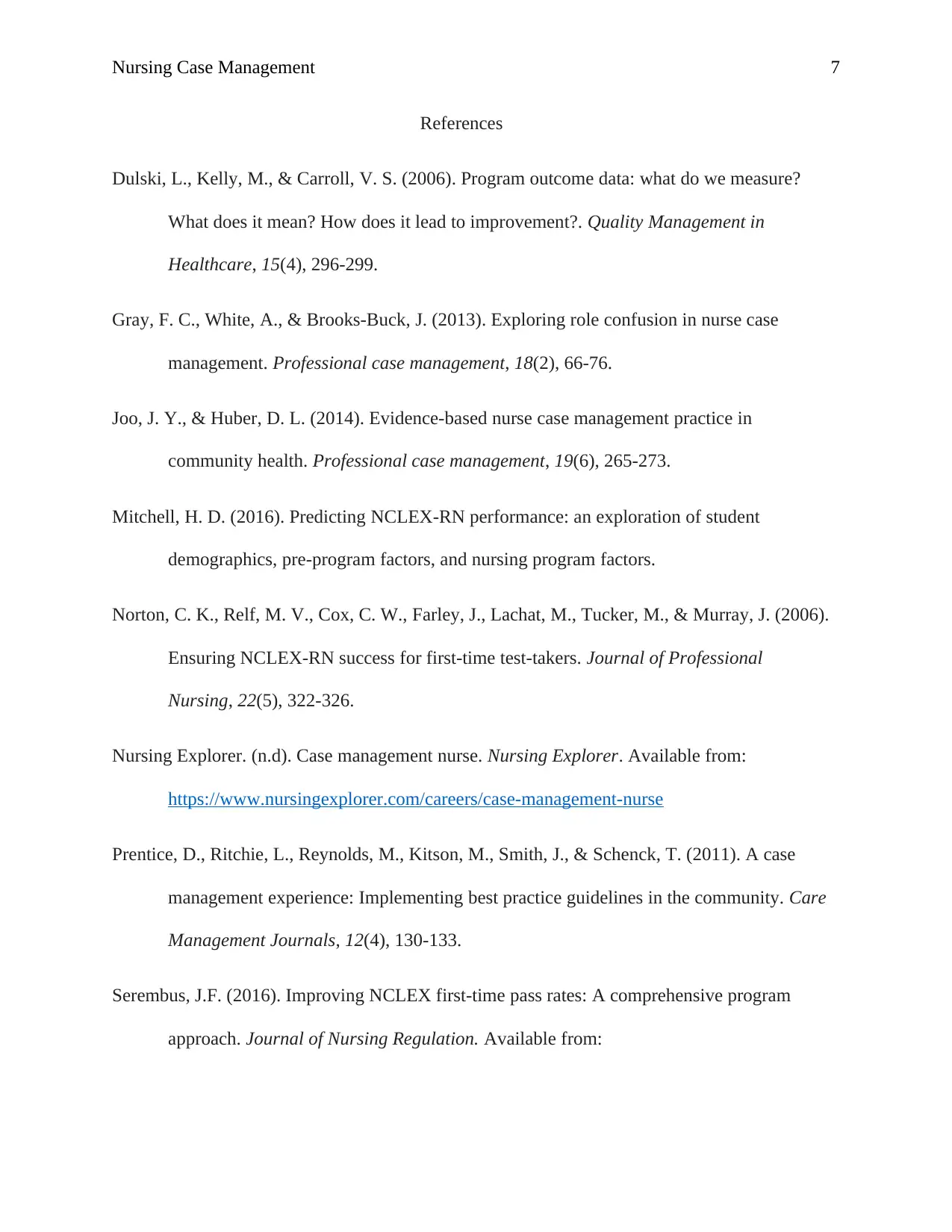
Nursing Case Management 7
References
Dulski, L., Kelly, M., & Carroll, V. S. (2006). Program outcome data: what do we measure?
What does it mean? How does it lead to improvement?. Quality Management in
Healthcare, 15(4), 296-299.
Gray, F. C., White, A., & Brooks-Buck, J. (2013). Exploring role confusion in nurse case
management. Professional case management, 18(2), 66-76.
Joo, J. Y., & Huber, D. L. (2014). Evidence-based nurse case management practice in
community health. Professional case management, 19(6), 265-273.
Mitchell, H. D. (2016). Predicting NCLEX-RN performance: an exploration of student
demographics, pre-program factors, and nursing program factors.
Norton, C. K., Relf, M. V., Cox, C. W., Farley, J., Lachat, M., Tucker, M., & Murray, J. (2006).
Ensuring NCLEX-RN success for first-time test-takers. Journal of Professional
Nursing, 22(5), 322-326.
Nursing Explorer. (n.d). Case management nurse. Nursing Explorer. Available from:
https://www.nursingexplorer.com/careers/case-management-nurse
Prentice, D., Ritchie, L., Reynolds, M., Kitson, M., Smith, J., & Schenck, T. (2011). A case
management experience: Implementing best practice guidelines in the community. Care
Management Journals, 12(4), 130-133.
Serembus, J.F. (2016). Improving NCLEX first-time pass rates: A comprehensive program
approach. Journal of Nursing Regulation. Available from:
References
Dulski, L., Kelly, M., & Carroll, V. S. (2006). Program outcome data: what do we measure?
What does it mean? How does it lead to improvement?. Quality Management in
Healthcare, 15(4), 296-299.
Gray, F. C., White, A., & Brooks-Buck, J. (2013). Exploring role confusion in nurse case
management. Professional case management, 18(2), 66-76.
Joo, J. Y., & Huber, D. L. (2014). Evidence-based nurse case management practice in
community health. Professional case management, 19(6), 265-273.
Mitchell, H. D. (2016). Predicting NCLEX-RN performance: an exploration of student
demographics, pre-program factors, and nursing program factors.
Norton, C. K., Relf, M. V., Cox, C. W., Farley, J., Lachat, M., Tucker, M., & Murray, J. (2006).
Ensuring NCLEX-RN success for first-time test-takers. Journal of Professional
Nursing, 22(5), 322-326.
Nursing Explorer. (n.d). Case management nurse. Nursing Explorer. Available from:
https://www.nursingexplorer.com/careers/case-management-nurse
Prentice, D., Ritchie, L., Reynolds, M., Kitson, M., Smith, J., & Schenck, T. (2011). A case
management experience: Implementing best practice guidelines in the community. Care
Management Journals, 12(4), 130-133.
Serembus, J.F. (2016). Improving NCLEX first-time pass rates: A comprehensive program
approach. Journal of Nursing Regulation. Available from:
Paraphrase This Document
Need a fresh take? Get an instant paraphrase of this document with our AI Paraphraser
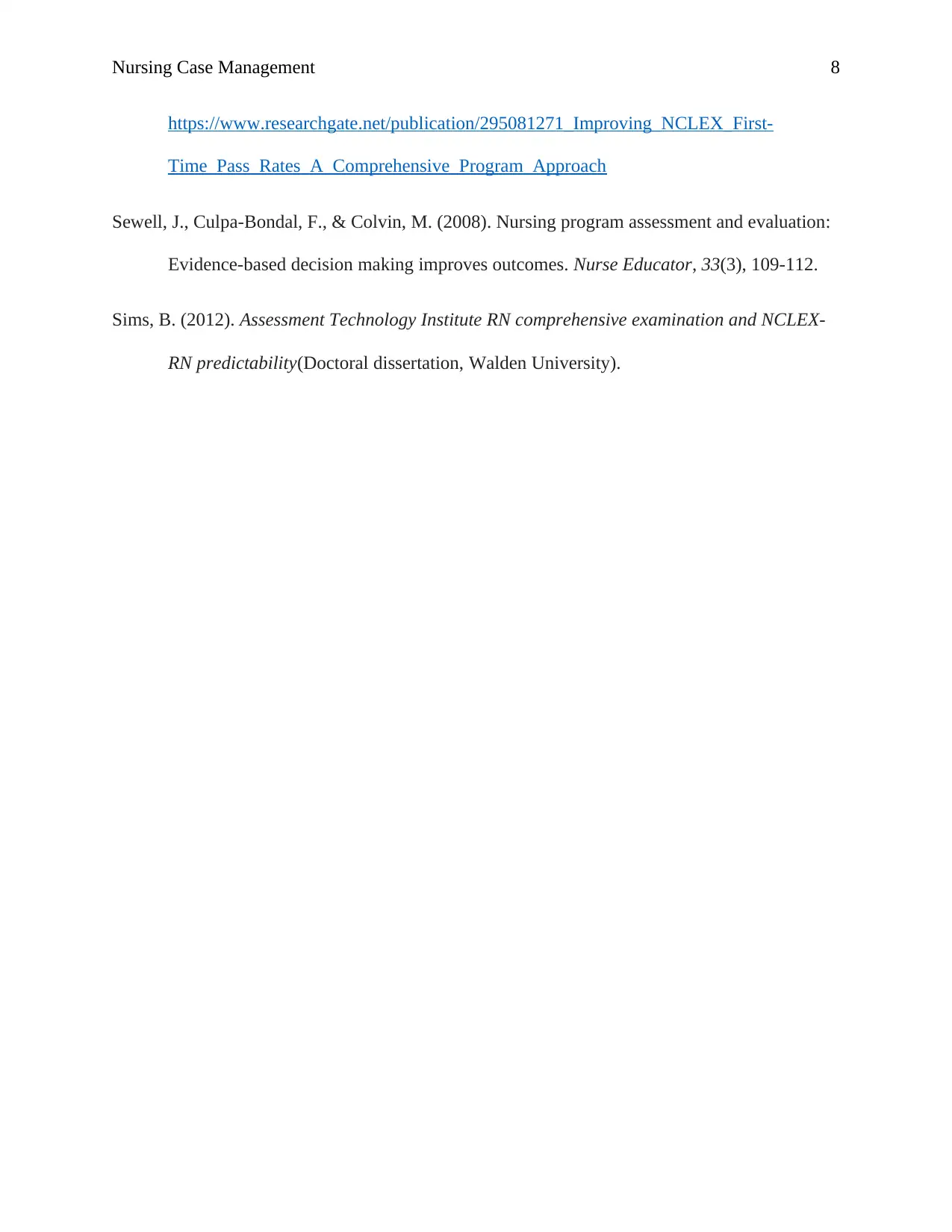
Nursing Case Management 8
https://www.researchgate.net/publication/295081271_Improving_NCLEX_First-
Time_Pass_Rates_A_Comprehensive_Program_Approach
Sewell, J., Culpa-Bondal, F., & Colvin, M. (2008). Nursing program assessment and evaluation:
Evidence-based decision making improves outcomes. Nurse Educator, 33(3), 109-112.
Sims, B. (2012). Assessment Technology Institute RN comprehensive examination and NCLEX-
RN predictability(Doctoral dissertation, Walden University).
https://www.researchgate.net/publication/295081271_Improving_NCLEX_First-
Time_Pass_Rates_A_Comprehensive_Program_Approach
Sewell, J., Culpa-Bondal, F., & Colvin, M. (2008). Nursing program assessment and evaluation:
Evidence-based decision making improves outcomes. Nurse Educator, 33(3), 109-112.
Sims, B. (2012). Assessment Technology Institute RN comprehensive examination and NCLEX-
RN predictability(Doctoral dissertation, Walden University).
1 out of 8
Related Documents
Your All-in-One AI-Powered Toolkit for Academic Success.
+13062052269
info@desklib.com
Available 24*7 on WhatsApp / Email
![[object Object]](/_next/static/media/star-bottom.7253800d.svg)
Unlock your academic potential
Copyright © 2020–2025 A2Z Services. All Rights Reserved. Developed and managed by ZUCOL.





